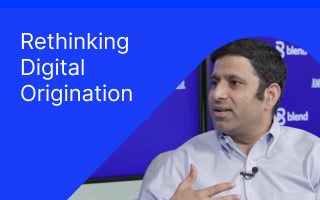August 3, 2021 in Thought leadership
Sustaining digital momentum post-pandemic and beyond
View a clip featuring Forward’s banking executive panel as we explore the most important strategy to sustain digital momentum.

Periods of innovation and social change are often byproducts of turbulent times: the Renaissance, the Roaring 20s, the post-World War II economic boom. We’ve just spent more than a year grappling with our own time of crisis. Priorities shifted quickly, increasing our reliance on technology as people began working, learning, and socializing remotely. For some industries, like financial services, the conditions created by the COVID-19 pandemic were a catalyst for the inevitable — large-scale digital transformation. From mortgages to consumer banking, financial services providers began reinventing their digital services.

The reactive measures that were taken in 2020 have largely proved successful, but for an industry that has relied on human interactions at bank branches, during loan applications, or at closings, consumer banking providers are now faced with the lingering challenge of engaging customers who are seeking more experiential digital interactions. Things are looking better than they were a year ago, but we’re not out of the woods.
As we shift into a recovery period, it’s important for financial services providers to reflect on these digital initiatives and figure out how to sustain early momentum. The end goal? Moving beyond “bridging the gap” so that they can add real — and sustainable — value to their customers’ lifetime financial journeys.
Same but different
Life is daily. As such, many of us are still going about our normal routines, but with some modifications: masking up, hours of Zoom calls, virtual happy hours or playdates. Financial services providers are also adapting. For the better part of their existence, banks offered a service of necessity to their customers: managing all aspects of their financial health. Take, for example, this survey from 2008. People primarily chose their banks out of proximity, affordability, or previous interactions, but the coronavirus changed that. Stay-at-home orders and social distancing forced banks to increase their digital services. While millennials and younger generations were already on board, older generations had to adapt to stronger technological integration, and they’ve become increasingly comfortable with it. Essentially, there’s no going back.
COVID-19 might have changed the face of banking, but on the upside, banks now have the opportunity to take a page out of the retail industry’s playbook and make the shift from transactional to experiential. Enter omnichannel capabilities. Just like their favorite store, consumers want to be able to choose how they interact with their financial services provider: in-person, on their preferred device, or a combination of both. Providing a seamless user experience is a critical piece of the puzzle, and strategic partnerships with tech companies that can provide that infrastructure can help keep financial institutions competitive. While once reserved for cutting-edge retailers, omnichannel strategies are now omnipresent — and regardless of the industry, they will be key to a company’s survival going forward.
Exceeding expectations
The movement toward digital banking was already underway prior to the pandemic, but once the reality set in and we collectively realized that social distancing and safety measures were going to be around for the foreseeable future, it became a necessity. This triggered a seismic shift in public attitudes toward digital financial operations, and banks around the country began reinforcing or even rebuilding their technology infrastructure. As time goes on, changes to the digital landscape are going to happen faster, and if financial services providers want to stay ahead of the curve, being proactive instead of just reactive could go a long way.
Modern consumers know what they want — they’ve often already done the research prior to making a big purchase or reaching a financial milestone. Giving people choices is no longer sufficient. We expect companies to anticipate our needs and preferences while interacting with us on a more personal level. A robust technological platform can increase personalization capabilities to help meet this need. Plus, with a strong omnichannel strategy, not only can banks meet consumers’ expectations, they can begin to exceed them. This is the key to sustaining momentum in a digital world; the experience is just as important as the outcome. Accelerated digital transformation has given companies the opportunity to embody a “journey vs. destination” mindset. Don’t just be there every step of the way, be one step ahead.
Find out what we're up to!
Subscribe to get Blend news, customer stories, events, and industry insights.

